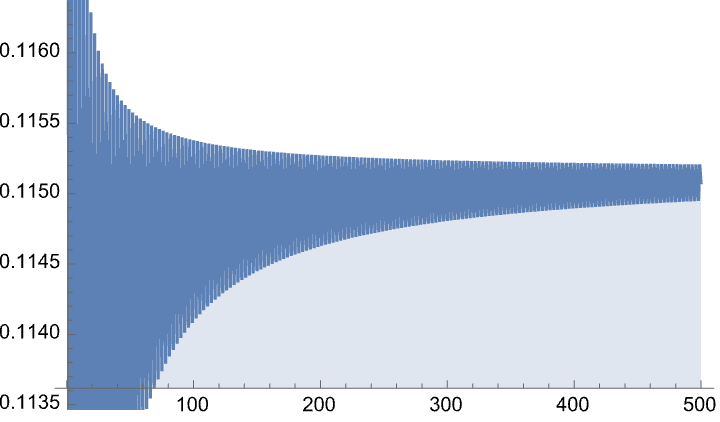I am desperately trying to solve a system of differential equations (post at mathoverflow helped me to clarify the asymptotic properties of the solution). In the meantime I've reduced 3 ODEs to just one
Clear[p,q,r]
p[a_,u_]:=-(16+u^2)^2+3 u^2 a^2 (36 u^4*a^4+3*u^2*(u^2-48)*a^2-u^4+8*u^2+192)
q[a_,u_]:= 2*u*a*(9*u^4*a^4-3*u^2*(u^2-4)*a^2-(u^2+16))
r[a_,u_]:= u^2*a^2*(3*u^2*a^2*(3*a^2-1)-1)
eq=r[a[u],u]+q[a[u],u]*a'[u]+p[a[u],u]*a'[u]^2==0
ic=a[0]==-1/2
I strongly believe that its analytic solution can be written as an order-12 curve in $a$ and $u^2$ variables (implicit solution) $$ \sum_{i=0}^{6}\sum_{j=0}^{12}C_{i,j}u^{2i}a^j(u)=0, \text{where }C_{0,0}\neq0. $$ I know that Maple can solve such equations in principle (see comments below this post). But it is also known that even to verify such an implicit solution is difficult with MA (Maple seems to do the verification without problems).
I would very much love to obtain the solution with MA. I am expecting that most of the $C_{i,j}$ coefficients should be zero, and the remaining ones should be small positive or negative integer numbers. For this reason I used FindIntegerNullVector, however, didn't find anything meaningful. I suppose that numerical solution was not accurate enough.

Background
The differential equation above is the result of many transformations. The initial system of equations is presented in MO post is given here for convenience in Mathematica form
λ[a_]:=a^3+1/4*a
Λ[a_]:=1/4 a^4+1/8*a^2
sys3odes={2a'[u]==u*x'[u],
4u*a[u]*x'[u]-4y'[u]==-2x[u]*D[u*a[u],u],
4u*a[u]*y'[u]-4x'[u]==D[u*λ[a[u]],u]-2y[u]*D[u*a[u],u]};
By combining Eq.(I) and (II) and integrating with given initial conditions we obtain
eqy=2y[u]==u*a[u]*x[u]+a[u]^2-1/4;
By adding y * Eq.(II) and x * Eq.(III) and integrating with given initial conditions we obtain
eqxy=4 u*a[u]*x[u]*y[u]-2(x[u]^2+y[u]^2)-u*x[u]*λ[a[u]]+2Λ[a[u]]==2Λ[-1/2];
We can verify these algebraic relations numerically:
{sa, sx, sy} = NDSolveValue[
Join[sys3odes, {a[0] == -1/2, x[0] == 0, y[0] == 0}], {a, x, y},
{u, 0, 1000}, WorkingPrecision -> 100, MaxSteps -> Infinity]
Plot[-2 sy[u] + u*sa[u]*sx[u] + sa[u]^2 - 1/4, {u, 0, 10}]
Plot[4 u*sa[u]*sx[u]*sy[u] - 2*(sx[u]^2 + sy[u]^2) - u*sx[u]*λ[sa[u]] + 2 Λ[sa[u]] - 2 Λ[-1/2], {u, 0, 10}]
I do not present plots, but they are indeed very close to zero. Next you eliminate $x(u)$ and $y(u)$.
Eliminate[{sys3odes[[1]],eqy,D[eqy,u],eqxy,D[eqxy,u]},
{x[u],x'[u],y[u],y'[u]}]//SubtractSides//Factor
Collect[Expand[%[[1,3]],a'[u]],a'[u]]
CoefficientList[%,a'[u]]//Simplify
In this way one gets the $r,q,p$ coefficients presented at the top of my post.


